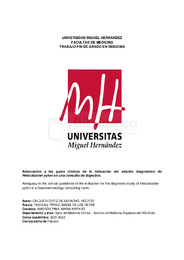Please use this identifier to cite or link to this item:
https://hdl.handle.net/11000/28478Adecuación a las guías clínicas de la indicación del estudio diagnóstico de Helicobacter pylori en una consulta de digestivo.
| Title: Adecuación a las guías clínicas de la indicación del estudio diagnóstico de Helicobacter pylori en una consulta de digestivo. |
| Authors: Calduch Ortiz de Saracho, Héctor |
| Tutor: Pascual Pérez, María de los Reyes Amorós Pina, María Amparo |
| Editor: Universidad Miguel Hernández |
| Department: Departamentos de la UMH::Medicina Clínica |
| Issue Date: 2022-02-09 |
| URI: https://hdl.handle.net/11000/28478 |
| Abstract: Antecedentes. Helicobacter pylori (Hp) es una bacteria altamente prevalente en la población mundial, no obstante, solo causa patología en un pequeño porcentaje de casos. Las indicaciones de su erradicación quedan descritas en la III Conferencia Española de Consenso sobre Helicobacter pylori (CEC-Hp), sin embargo, no hay apenas información acerca del grado de cumplimiento de las mismas en la práctica clínica. Objetivo principal. Cuantificar el porcentaje de adecuación a la III CEC-Hp del motivo por el que se inicia estudio diagnóstico de Hp, en aquellos pacientes sometidos a un test de aliento con urea marcada (TAU) en el Centro de Especialidades Padre Manjón (Elda) durante los años 2018 y 2019. Material y métodos. Se realizó un estudio descriptivo, retrospectivo y observacional en el que se incluyeron todos aquellos pacientes que se realizaron un TAU en el Centro de Especialidades Padre Manjón durante los años 2018 y 2019. Se registraron datos acerca de la indicación de tratamiento erradicador, esquemas de tratamiento y resultados del TAU posterior para comprobar su efectividad. Resultados. La adecuación a la III CEC-Hp de la indicación de estudio diagnóstico de Hp fue del 91,37% (n=434), siendo solo un 8,63% (n=41) por motivos no contemplados. Del total de pacientes, la indicación más frecuente fue la dispepsia (43,16%) y entre las no contempladas por la III CEC-HP fue la cirugía bariátrica (46,34%). Las terapias con Pylera® 10 y OCAM 14 fueron las más pautadas en primera línea para no alérgicos a betalactámicos (36,39% y 32,39%) y las que alcanzaron tasas de erradicación más próximas al 90% (88,24% y 90,43%), sin diferencias significativas entre ellas (p>0,05). El 70,13% de las terapias pautadas pertenecen al algoritmo de tratamiento, siendo solo un 34,28% OCAM 14. Conclusiones. Existe una alta adecuación a la III CEC-Hp para la indicación de inicio de estudio diagnóstico de Hp en nuestro medio, siendo correcta en aproximadamente 10 de cada 11 pacientes. La indicación más frecuente fue la dispepsia de cualquier causa y el motivo ajeno a la III CEC-Hp fue la cirugía bariátrica. De cada 10 tratamientos de primera línea, 7 pertenecen al algoritmo de tratamiento de la IV CEC-Hp, siendo solo 3 de ellos la terapia recomendada para el escalón terapéutico. OCAM 10 sigue siendo una terapia muy frecuente en primera línea, a pesar de haberse demostrado su inferioridad respecto a OCAM 14 y Pylera® 10, siendo estas últimas, las pautas más frecuentemente utilizadas y las que tienen mayor tasa de erradicación, sin diferencias significativas entre ellas. Background. Helicobacter pylori (Hp) is a highly prevalent bacterium worldwide, however, it only causes pathology in a small percentage of cases. The indications for its eradication are described in the III and IV Spanish Consensus Conference on Helicobacter pylori (CEC Hp), yet, there is little information about the degree of compliance with them in clinical practice. Mean objective. To quantify the percentage of adequacy to the clinical guidelines of the reason for starting a Helicobacter pylori diagnostic study, in those patients submitted to a urea breath test (TAU) at the Padre Manjón Specialty Center (Elda) during the years 2018 and 2019. Material and methods. A descriptive, retrospective and observational study was carried out in which were included all those patients who underwent a TAU at the Padre Manjón Specialty Center during the years 2018 and 2019. Data on the indication for eradication treatment, treatment schemes and results of the subsequent breath test were recorded to verify its effectiveness. Results. The compliance with the III CEC-HP for the indication for diagnostic study of Hp was 91,37% (n=434), with only 8,63% (n=41) being for reasons not considered. Among all patients, the most frequent indication was dyspepsia (43,16%) and among those not covered by the III CPB-HP was bariatric surgery (46,34%). Pylera® 10 and OCAM 14 were the most frequently prescribed first-line therapies for those not allergic to beta-lactams (36,39% and 32,39%) and those that achieved eradication rates closer to 90% (88,24% and 90,43%), with no significant differences between them (p>0,05). 70,13% of the prescribed therapies belong to the treatment algorithm, with only 34.28% being OCAM 14. Conclusions. There is a high compliance with the III CPB-Hp for the indication for initiating a diagnostic study of Hp in our series, being correct in approximately 10 out of 11 patients. The most frequent indication was dyspepsia of any cause and the reason outside of III CEC-Hp is bariatric surgery. Of every 10 first-line treatments, 7 belong to the IV CEC-Hp treatment algorithm, with only 3 of them being the recommended therapy for the therapeutic step. OCAM 10 continues to be a very frequent first-line therapy, despite having been shown to be inferior to OCAM 14 and Pylera® 10, being these the most frequently prescribed drugs and those with the highest eradication rates, with no significant differences between them. |
| Keywords/Subjects: Helicobacter pylori Diagnóstico Tratamiento Efectividad del tratamiento Conferencia de consenso |
| Knowledge area: CDU: Ciencias aplicadas: Medicina |
| Type of document: info:eu-repo/semantics/bachelorThesis |
| Access rights: info:eu-repo/semantics/openAccess Attribution-NonCommercial-NoDerivatives 4.0 Internacional |
| Appears in Collections: TFG- Medicina |
.png)

